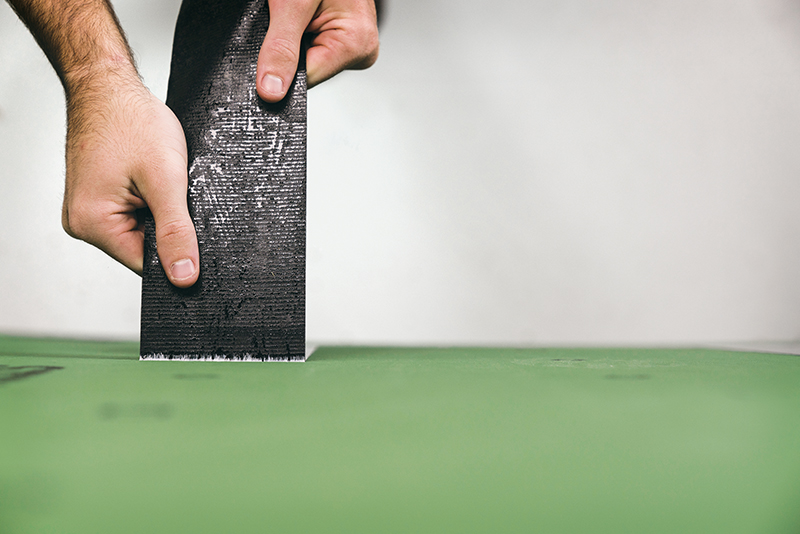Pressure-sensitive flashing tapes have become increasingly commonplace on today’s jobsites, but many of the contractors who use them don’t understand how they work. They think that what causes these tapes to be so sticky is some sort of chemical reaction, as with two-part epoxy or expanding foam, but it’s not that. It’s actually a chemical bond created by the physical interaction of two molecular forces: adhesion and cohesion.
Adhesion is what makes the tape stick to the sheathing. It also affects the viscosity or “liquid” property of the adhesive, which is what allows it to spread or “wet out” onto the substrate. Cohesion holds the adhesive together and affects its elasticity, which is what allows it to resist separation from the substrate when a force is applied to it.
But how well these forces work in pressure-sensitive flashing tapes depends on jobsite conditions and the care with which the tape is installed.

Pressure
Flashing tapes that use a pressure-sensitive adhesive literally require you to press on the tape to activate the adhesion and cohesion. By applying pressure, you jump-start the flow of the adhesive into the substrate, whether it’s OSB, plywood, framing lumber, or some other material [1]. You really need the pressure to get the adhesive moving so it will fully “wet out” and work its way into the microscopic voids in the surface of the material. Pressure is best applied to tape using a J-roller, a plastic squeegee, or similar tool to mash the tape into the surface [2]. Not only does this help prevent fishmouths and wrinkles in the tape, but it kicks the viscous flow of the adhesive into gear, enabling it to work its way into all the nooks and crannies of whatever material you’re trying to stick it to.
Find more Building Science here
Temperature
The other critical variable is the temperature range during installation. If it’s too cold, the adhesive will be too stiff and won’t flow well, so it won’t wet out on the surface of the substrate. On a vertical wall the tape might stick temporarily, but without pressure it will never get a good bond to the substrate—even gravity will be enough to cause the tape to peel off. I’ve heard of people using staples to hold the tape in place during cold weather with the expectation that as the temperature warms, the tape will stick better. But heat alone is not enough for pressure-sensitive tapes: They need to be applied using pressure to wet the adhesive into the surface.

On the opposite end of the temperature scale, if it’s too hot during installation, the adhesive will flow too much and lose its cohesion. On a hot, sunny roof deck, for example, you can sometimes see tape or peel-and-stick membrane that has started to slide, especially if workers have stepped on it or stacked heavy roofing bundles on it.
The sun’s UV radiation can also break down the cohesive bonds in the tape. That’s why advanced tapes have several layers: In addition to the adhesive layer, you might have two or three different materials that make up the backing film, some of which act as UV inhibitors to slow down any UV degradation that could ultimately weaken the adhesive.
 Long-term Adhesion
Long-term Adhesion
Once you install the tape and press it into the surface, it can take some time to reach maximum stickiness, depending on what kind of tape you’re using. Adhesive strength varies, depending on the viscoelastic properties of the adhesive chemistry in the tape. Butyl, for example, might have more flow initially, so it can achieve higher adhesive strength right up front, but that might degrade over time. An acrylic, by contrast, tends to build adhesive strength over time because it wets out more slowly. If pressure is properly applied, you’re continuing to get wet out, so strength is building [3].
The Future of Tape
Flashing tapes have become commonplace in both new construction and remodeling. Increasingly, they are becoming more and more accepted as key components of a water resistant barrier or air barrier system. In the future, we think that means there’s going to be more interest in the vapor permeance aspects of tapes to ensure proper drying potential. We’ve done a good job creating tapes that keep water from getting into the building; now, we’re thinking more about how to create tapes that also let water out of the building.
Add new comment
Related Stories
Home Improvement Success: Luck, Hard Work, or Who You Know?
Even the most brilliant marketing mind could see fewer opportunities due to lack of networking
Homeowner Trends When Selecting Manufactured Stone
On this episode of Rock Stars of Remodeling, ProVia Product Manager of Stone & Roofing Chance Shalosky joins host Drew Barto to reveal design and color trends that contractors should consider when selling manufactured stone in 2024
Why A Successful Custom Remodeler Started a One-Day Bath Business
On this episode of Rock Stars of Remodeling, Showcase Remodels Owner Sam DeMaio shares why he decided to add a one-day bath business and offers tips on how contractors can accumulate wealth
Learn from the Best in Home Improvement and Remodeling
This year’s Pinnacle Experience aims to help remodelers stay ahead of their competitors by featuring captivating keynote speakers and subject matter experts, collaborative roundtable discussions, and networking with proven players from across the country.
Get the Most Out of Your Teams with This Leadership Style
The transformational leadership style focuses on inspiring and motivating team members to achieve their full potential and exceed their expectations
3 Reasons Contractors Should Set Same-Day Sales Appointments
Director of Home Improvement Drew Barto writes that contractors that aren't implementing same-day sales appointments are missing out on opportunities to close more business
Registration Open for The Pinnacle Experience 2024
Register today for The Pinnacle Experience 2024 in Baltimore from June 26-28. Join the best and brightest in home improvement and remodeling for insight, advice, and relationship-building that will help you take your business to new heights.
How Contractors Can Determine Lead Value
On this episode of Rock Stars of Remodeling, Builder Prime Founder and CEO Jonathan Weinberg reveals how contractors can effectively determine the value of each lead to their business, and why they must do so
24 Marketing Tips for Home Improvement Contractors in 2024
Quick-hitting advice on how contractors can increase and enhance lead flow in 2024
Rising Financing Fees to Impact Home Improvement Industry
NEWPRO Home Solutions COO shares his expert insight on the challenges facing the home improvement industry in 2024 for Pro Remodeler's Thought Leader predictions series












